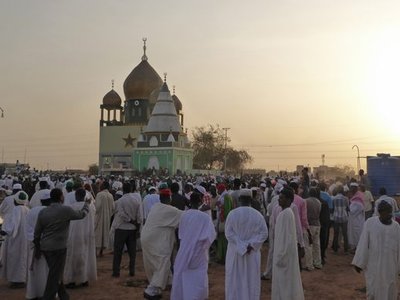Sheikh Hamad-al Nil Tomb


Every Friday evening, Sufi dervishes
perform a ritual called
dhikr
at the tomb of Sheikh Hamad-al Nil, a 19th-century Sufi leader. The devotees dance and work themselves into a frenzy while reciting Allah’s name, helping to create a state of ecstatic abandon that supposedly allows their hearts to communicate directly with God.
The ceremony begins when the dervishes make their entrance to the cemetery dressed in colorful patchwork robes with bright beads draped around their necks. They then proceed to a patch of cleared ground in front of the mosque while banging drums and chanting while a man attempts to enforce the perimeter boundary.
Although he carries a large club, he still struggles to maintain order as the crowd is, by now, wild with excitement. Fights break out among the more belligerent adherents who appear to taunt each other (quickly dealt with by the club-wielding man). Wild-eyed priests dance around the perimeter and blow incense into the faces peering out from the mass of spectators.
The proceedings become more electric as the evening wears on. The rhythmic chants of “
La Illaha Illallah
” (there is no god but Allah) become hypnotic. Every so often a devotee breaks off from the main group, spinning in a blur of arms and legs. With eyes rolling, the dancer seems to enter into a trance-like state before collapsing onto the ground.
The ceremony begins around 4:30. Visitors are treated with respect despite the fighting and theatrical bad tempers among devotees. It’s hard not to be swept along with the ritual. When it ends, you almost feel as if you’ve suddenly snapped out of your own trance.